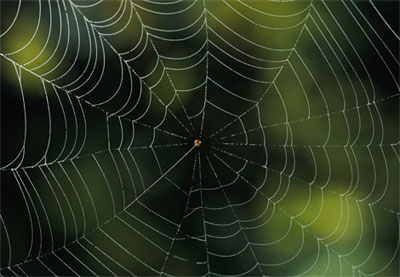Spider silk may have springs or rubber properties
This rugged and durable material is stronger than steel, tougher than nylon and is better elastic than Kevlar. So what material is it? Not far away is spider silk.
Understanding how to create spider silk is one of the wonders of the material industry. John Gosline throughout his career as a scientist has always been fascinated by spider silk and its amazing durability.
He explained that if we want to learn how to create spider silk, we must understand the relationship in the components as well as the mechanical properties of the silk fibers. That's why he focuses on dragline silk - one of the many types of silk that spiders create.
According to Gosline, spiders use dragline silk of course with the purpose of making zippers, creating frames and radiating structures of spider webs. Any spider web requires huge amounts of energy to build without breaking. Comparing the amino acid order of the protein in the silk between Araneus diadematus and Nephila clavipes, Gosline discovered the difference in each species. Araneus spider silk is rich in proline amino acids while the proline ratio in Nephila spider silk is very low.
Curious with the effect of protein on each type of silk, Gosline and students Ken Savage compared the mechanical properties of two silk types to understand how the proline amino acid affects the strength of spider silk. .
However, obtaining the sample silk is also a problem. Gosline explains that spiders often regulate silks depending on their conditions. So he and Savage had to leave the spiders free to make sure that the dragged silk was as uniform as possible. After obtaining a reliable source of silk, Savage experimented with the mechanical properties of silk. Very careful in stretching dry silk yarn to measure force, the group quickly found that the two types of silk above have similar characteristics, the presence of proline has little or no effect on the properties of Dried silk.

(Photo: National Geographic)
But when Savage began studying hydrated silk, it was a completely different story. At first, Araneus's wet silk shrank and then swelled more than proline-deficient silk of Nephila spiders. Savage also tested the silk stiffness and found that Nephila spider silk was nearly 10 times stiffer than the Araneus spider silk. Finally, knowing the concentration of proteins in silk to create microscopic crystals in a thread, Savage measured the double-refractive index (birefringence) of silk to compare the two types of silk, copper. The answer to the question is whether the protein structure of silk changes when wet or not. Proteins in Nephila silk are always more organized than proteins in Araneus spider silk whether wet or dry. When Savage pulls the thread, the level of organization of hydrated Nephila spider silk is much higher than Araneus silk.
Gosline found that different mechanical properties can be derived from the amino acid composition of proteins in spider silk. According to him, proline amino acid is characterized by a breakdown of the three-dimensional structure of the protein chain, so the protein sequence with a high proline ratio is less durable than the protein chain with little or no proline. Araneus spider silk contains about 16% of proline mainly in the connection area in the crystal structure of the protein that makes the joint flexible and changeable abnormally. Gosline realizes that if this is the case, hydrated silk will look like a elastic band.
In contrast, Nephila spider silk has a very low proline ratio in the connection area, making the joint more durable, bearing the characteristics like a solid spring. Gosline and Savage decided to study the tension of both types of silk to find out whether they are similar to rubber or spring.
Pulling the sample hydrate, Savage slowly raised and lowered the temperature from 300 C to 100 C while carefully measuring the force needed to maintain the tension. For Nephila spider silk, the sustaining force is quite stable when the temperature changes suggesting it has spring elasticity. As for proline-rich Areneus silk, the force changes in proportion to the temperature like a rubber band. So proline-rich spider silk fibers have the characteristics of rubber, and spider silk with low proline rate is like a solid spring.
After finding the surprising effect of proline amino acid on the mechanical characteristics of hydrated spider silk, Gosline and Savage continue to understand why it is impossible to distinguish the properties of dry silk and the different proline ratio. What functions for spider silk.
- Spider silk can transmit sound waves very well
- Spider silk - Biomaterial of the future
- Bulletproof vests will be made of spider silk
- Discover the mystery of spider silk
- Producing artificial spider silk lighter than cotton, more durable than steel
- Spider-Man's weapons are not logical about science
- The secret of spider silk
- Video: How to clean up the silk inside a spider?
- Found a way to transform genes to create spider silk like Spider Man
- See the silk spider, you will have to recognize this is a great architect of the animal world
- Detection of spider silk formation mechanism
- Lightweight fabric from artificial spider silk
 'Fine laughs' - Scary and painful torture in ancient times
'Fine laughs' - Scary and painful torture in ancient times The sequence of numbers 142857 of the Egyptian pyramids is known as the strangest number in the world - Why?
The sequence of numbers 142857 of the Egyptian pyramids is known as the strangest number in the world - Why? History of the iron
History of the iron What is alum?
What is alum?